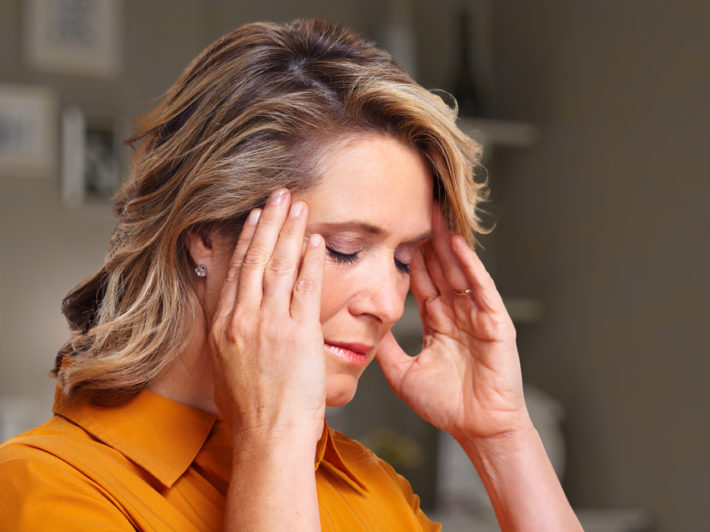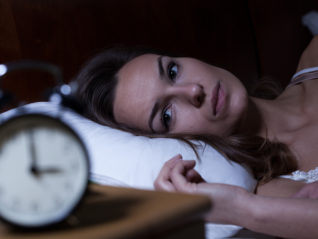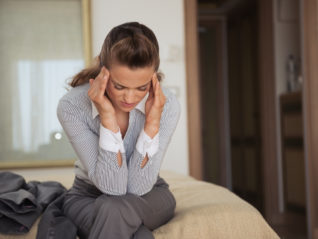
by Bianca Garilli, ND
Migraines are a painful, oftentimes debilitating condition experienced by over 20% of women and 10% of men throughout their lifetime; according to the World Health Organization’s 2012 Global Burden of Disease figures, migraines ranked in the top 40 conditions causing worldwide disability.1
Causes of migraines vary. Some have genetic etiology, while other people are triggered by known external or internal causes. But for some migraine sufferers, the origin is a mystery, making the ailment even more frustrating to deal with.1 Hallmark clinical features of migraines include nausea, dizziness, extreme sensitivity to external stimuli, and bowel function disturbances, in addition to the intense, throbbing pain most commonly associated with the condition.1
Most people who experience migraines have their first episodes while still in their teens or 20s, although approximately 10% of children may also be affected by the condition.2 The most common age group afflicted by migraines are 25 to 55 year olds.2,3
A gender bias for migraine suffering exists. Like many other health issues, including autoimmune disease, stroke, depression, anxiety, and osteoarthritis, migraines affect women more frequently than their male counterparts.4 This is thought to be, in part, triggered by fluctuating sex hormone levels experienced by women throughout their lifetime. Many women who suffer from chronic migraines find that their migraines improve or altogether disappear at menopause, further supporting the biological underpinning of sex hormones and hormonal patterns in migraine etiology.
Migraines and the menstrual cycle
Menstrual migraine (sometimes termed catamenial migraine), is comprised of two subtypes – the pure menstrual migraine and the menstrually related migraine. The pure menstrual migraine is one that occurs on day 1 + 2 of menstruation and at no other time of the cycle; it happens during at least 2 of 3 consecutive menstrual cycles, and no aura is present.5-7 Similarly, no auras are associated with the menstrually related migraine, which occurs on day 1 + 2 of menstruation but in contrast, this type of migraine can also come about at other times in the menstrual cycle; this must be present during at least 2 of 3 consecutive menstrual cycles.5,6 It is worth mentioning that, while this describes the typical clinical presentation, there are exceptions, for example a case report of a perimenopausal woman who experienced sensory aura7 that exclusively heralded pure menstrual migraines.8
Most commonly, the trigger for these menstrual migraines is a sharp drop in estrogen, typically 2 to 3 days before the start of menstruation.9 This decline is hypothesized to, “unmask non-nuclear mitogen-activated hyperexcitability of cell membranes,” leading to the oversensitization of neurons, which trigger the resultant migraine.9 Moreover, low levels of estrogen may increase inflammatory activity and increase peptide-modulated central sensitization, which can lead to higher levels of pain and disability during migraines.9 If estrogen is administered premenstrually, migraines can be delayed without affecting onset of menses.6 Moreover, it has been shown that giving long-acting estrogen implants, delivering uneven amounts of estrogen throughout the cycle, may trigger migraines.6
Migraines and perimenopause
Some women experience worsening or more frequent migraines during the perimenopausal years. This makes sense considering that estrogen and other hormone levels can fluctuate widely and unevenly during the years between “regular” menstrual cycles and menopause.10 In fact, research suggests that women with a history of menstrual migraines may have increased risk of worsening migraines during perimenopause.11
Migraines and sleep
Migraines during perimenopause may be further exacerbated by sleep problems often experienced during these years. Many women note sleep can be disrupted by hot flashes, restless legs syndrome, sleep apnea, anxiety, and many other problems leading to fewer hours of quality sleep. In fact, 56% of perimenopausal women sleep < 7 hours/night on average, and over 30% have difficulty staying asleep at least 4 nights per week.12
A cross-sectional, case-control study examining the link between sleep quality and migraine frequency in 357 male and female Taiwanese individuals from an outpatient headache clinic.13 Higher migraine frequency was associated with poor sleep quality and a higher prevalence of poor sleepers using the Pittsburgh Sleep Quality Index (PSQI) tool.13 Further, high migraine frequency was shown to be an independent factor for poor sleep quality; a possible bidirectional effect between poor sleep quality and migraines may be at work here.13
It has also been suggested that individuals suffering from chronic migraines (≥ 15 headache days/month) present with more severe insomnia symptoms than individuals with episodic migraines (0-14 headache days/month) possibly predisposing chronic migraine patients to more frequent headache days through insomnia’s effect on the pain-processing trigeminovascular system.13,14 Once again, reinforcing the possibility of a bidirectional relationship between sleep and migraines.
Research has shown that melatonin can increase total sleep time and sleep efficiency as well as reduce sleep latency in patients with insomnia.16 This is especially interesting when taking into account that melatonin secretion from the pineal gland drops throughout perimenopause.17 Therefore, it has been suggested that providing this hormone exogenously may not just improve sleep in perimenopausal women, but may also reduce their risk of migraine.17 This was played out in a randomized, double-blind, placebo controlled trial looking at 196 adult migraine sufferers.18 Participants were randomized to 3 mg melatonin, 25 mg amitriptyline, or a placebo for 3 months; results demonstrated that average migraine frequency (number of days) was reduced by 2.7 days in the melatonin group, 2.2 with amitriptyline, and 1.1 for placebo.18 In addition to being better tolerated than amitriptyline, melatonin was superior to amitriptyline in the percentage of patients who achieved > 50% reduction in migraine frequency.18
Migraines and HRT
Hormone replacement therapy (HRT) may offer an additional option for supporting migraine event reduction during perimenopause, as was discussed in a paper published in the Journal of Family Planning and Reproductive Healthcare.19 HRT may be considered in perimenopausal women suffering from migraines when additional perimenopausal symptoms are also present; it is recommend that the lowest effective dose necessary to control symptoms be used.19
Many women, thankfully, find that menstrual migraines tend to dissipate and often resolve altogether within a few years of menopause due to the disappearance of perimenopausal estrogen yo-yoing and sharp dips in estrogen levels, in addition to the greater stability in hormone balance overall. Studies show that 62% of prior headache sufferers report a significant decrease in headaches after menopause.20
Supporting migraine reduction with personalized lifestyle and functional medicine
Many evidence-based approaches exist to combat migraines. Working with a healthcare practitioner (HCP) trained in Functional Medicine will ensure that the root cause(s) of the migraines is/are understood, which will then serve as the foundation for an effective, individualized therapeutic approach. Migraine management considerations should initially focus on the foundations of health which include the lifestyle components of nutrition and sleep, along with exercise and stress modification.
Lifestyle support
Adequate hydration, restful and adequate sleep, regular exercise and movement, smoking cessation, maintenance of a healthy body weight, blood glucose balance, and utilization of effective stress-modifying behaviors21 (e.g., meditation22) have all been shown to support a reduction in migraines.
Additional therapeutics may be layered into the migraine plan based on the personalized needs of the individual patient. These options include specific dietary approaches, botanicals, micronutrients and nutritional bioactives, acupuncture, and cognitive behavioral therapy for insomnia (CBT-I)15 to name a few. Several of these options are explored in more detail below.
Dietary approach
One size does not fit all when it comes to dietary approaches to migraines. Various diets with diverse macronutrient distributions have been studied to date for migraine management, and the recommended nutritional approach should be individualized by the HCP based on all clinical issues the patient is experiencing, including migraines. Anti-inflammatory,21 ketogenic,23,24 low-glycemic index,25 low lipid,26 and low-tyramine27 diets have all been demonstrated to provide migraine relief. Additionally, tracking and avoiding food triggers, which vary person by person, can also bring migraine relief to some. The most common triggers include alcohol, chocolate, cheese, caffeine, and monosodium glutamate (MSG).28 Certain patients may also be triggered by other foods/food substances, like tyramine, phenylethylamine, aspartame, nitrates, and nitrites.28
A study from Brazil looking at migraine triggers in 200 participants, 162 women and 38 men, found that the most frequent precipitating factors for migraines were dietary (84.5%), followed by sleep disturbances (75.5%), environmental factors (68.5%) including cigarette smoking, stress (65%), hormonal factors (43.5%), and exertional activities (15.5%).29 In order of individual nutrition-related factors, fasting (skipping meals) was the most common risk associated with migraines by participants, while alcohol consumption, chocolate, and caffeine intake also made the short list.29 For hormonal contributors, the pre-menstrual period was the most precipitous migraine trigger.29
Tyramine, a derivative of the amino acid tyrosine, has been hypothesized to play a role in triggering migraines possibly via its effect on serotonin and norepinephrine levels, with a subsequent influence on cranial vessel vasoconstriction followed by rebound vasodilation.30,31 A low-tyramine diet has proved helpful in some migraine cases; this requires a reduction or elimination of high-tyramine foods, including aged or cured foods such as aged cheeses, smoked fish, cured meats, fermented foods, certain nuts, chicken liver, yeast extract, and some types of beer.28,30
Regardless of the dietary approach, improving diet quality is the goal, since nationally representative data indicates that diet quality is lower in female migraineurs than women without migraines aged 20-50 years.32
Botanicals
Vitex agnus-castus (chasteberry),33 Petasites hybridus (butterbur),34 and Tanacetum parthenium L. (feverfew)28 are just three of the many botanicals that can be used to support patients with migraine. It is important to discuss their utilization with a healthcare provider knowledgeable in botanical medicine, for dosing and formulation vetting, as well as to screen for possible contraindications or drug-herb interactions.
Micronutrients & nutritional bioactives
Vitamins B1 (thiamin), B2 (riboflavin), and B6, as well as magnesium, CoQ10, and alpha lipoic acid may be useful in clinical protocols for migraine relief.28,35 Exogenous ketone salts (e.g., β-hydroxybutyrate) may also mitigate migraines.36 As in so many other disease processes, disturbances or dysbiosis of the gut microbiota can also influence migraine events through the gut-brain connection.36 Recent science suggests that dietary interventions or probiotic supplementation aimed at improving gut microbial balance, reducing gut inflammation, and optimizing gut membrane permeability may also play a role in the reduction of migraines.37
Partnering with patients to achieve a personalized, targeted nutrition regimen and to optimize and individualize composition and dosing is the ultimate goal.
In summary, while migraines have diverse etiology, hormonal patterns associated with the menstrual cycle and perimenopause may significantly contribute to migraines in many women. Functional and personalized lifestyle medicine approaches to migraines in pre- and perimenopause offer a toolbox of options that can help provide relief to female migraineurs. The options are numerous. Here is a list highlighting some of the many ways you can provide support to patients with migraines:15,18,19,28,29,38
- Melatonin supplementation
- HRT/BHRT
- Individualized dietary approaches
- Botanicals
- Micronutrients & nutritional bioactives
- Caffeine reduction or removal
- Smoking cessation
- Stress reduction techniques
- Acupuncture
- Massage
- Chiropractic care
- Yoga
- CBT-I
Citations
- Weatherall MW. The diagnosis and treatment of chronic migraine. Ther Adv Chronic Dis. 2015;6(3):115–123.
- The Migraine Foundation. Migraines. https://migraineresearchfoundation.org/about-migraine/migraine-facts/ Accessed January 29, 2019.
- The Migraine Trust. Menopause and midlife. https://www.migrainetrust.org/about-migraine/trigger-factors/menopause-and-midlife/ Accessed January 29, 2019.
- NIH. What heath issues or conditions affect women differently than men? https://www.nichd.nih.gov/health/topics/womenshealth/conditioninfo/howconditionsaffect Accessed January 29, 2019.
- International Headache Society. IHS Classification. https://www.ichd-3.org/appendix/a1-migraine/a1-1-migraine-without-aura/a1-1-1-pure-menstrual-migraine-without-aura/ Accessed February 13, 2019
- Mathew PG et al. A cyclic pain: the pathophysiology and treatment of menstrual migraine. Obstet Gynecol Surv. 2013;68(2):130-140.
- Mayo Clinic. Video: migraine aura. https://www.mayoclinic.org/diseases-conditions/migraine-with-aura/multimedia/migraine-aura/vid-20084707. Accessed February 15, 2019.
- Chen JJ et al. Pure menstrual migraine with sensory aura: a case report. J Headache Pain. 2012;13(5):431-433.
- MacGregor EA. Menstrual migraine: the therapeutic approach. Ther Adv Neurol Disord. 2009;2(5):327–336.
- Mayo Clinic. Headaches and Hormones. https://www.mayoclinic.org/diseases-conditions/chronic-daily-headaches/in-depth/headaches/art-20046729 Accessed January 30, 2019.
- Ripa P et al. Migraine in menopausal women: a systematic review. Int J Womens Health. 2015;7:773-782.
- CDC. Sleep duration and quality among women aged 40-59, by menopausal state. https://www.cdc.gov/nchs/products/databriefs/db286.htm. Accessed January 25, 2019.
- Lin YK et al. Associations between sleep quality and migraine frequency: a cross-sectional case-control study. Medicine (Baltimore). 2016;95(17):e3554.
- Katsarava Z et al. Defining the differences between episodic migraine and chronic migraine. Curr Pain Headache Rep. 2012;16(1):86–92.
- Yang CP et al. Sleep in patients with chronic migraine. Curr Pain Headache Rep. 2017;21(9):39.
- Jehan S et al. Sleep disorders in postmenopausal women. J Sleep Disord Ther. 2015;4(5):1000212.
- Jehan S et al. Sleep, melatonin, and the menopausal transition: what are the links? Sleep Sci. 2017;10(1):11–18.
- Gonçalves AL et al. Randomised clinical trial comparing melatonin 3 mg, amitriptyline 25 mg and placebo for migraine prevention. J Neurol Neurosurg Psychiatry. 2016;87(10):1127–1132.
- MacGregor AE. Migraine, the menopause and hormone replacement therapy: A clinical review. J Fam Plann Reprod Health Care. 2007;33(4):245-249.
- Stovner LJ et al. The global burden of headache: a documentation of headache prevalence and disability. Cephalalgia. 2007;27(3):193-210.
- Brandes JL. Migraine in women. Continuum (Minneap Minn). 2012;18(4):835–852.
- Keller A et al. Migraine and meditation: characteristics of cortical activity and stress coping in migraine patients, meditators and healthy controls- an exploratory cross-sectional study. Appl Pyschophysiol Biofeedback. 2016;41(3):307-313.
- Barbanti P et al. Ketogenic diet in migraine: rationale, findings and perspectives.Neurol Sci. 2017;38(Suppl 1):111-115.
- Di Lorenzo C et al. Efficacy of modified Atkins ketogenic diet in chronic cluster headache: an open-label, single-arm, clinical trial. Front Neurol.2018;9:64.
- Evcili G et al. Early and long period follow-up results of low glycemic index diet for migraine prophylaxis. Agri. 2018;30(1):8-11.
- Ferrara LA et al. Low-lipid diet reduces frequency and severity of acute migraine attacks. Nutr Metab Cardiovasc Dis. 2015;25(4):370-375.
- Rist PM et al. Dietary patterns according to headache and migraine status: a cross-sectional study. Cephalalgia. 2015;35(9):767-775.
- Sun-Edelstein C et al. Foods and supplements in the management of migraine headaches. Clin J Pain. 2009;25(5):446-452.
- Fukui PT et al. Trigger factors in migraine patients. Arq Neuropsiquiatr. 2008;66(3A):494-499.
- National Headache Foundation. Tyramine. https://headaches.org/2007/10/25/tyramine/. Accessed February 13, 2019
- Millichap JG et al. The diet factor in pediatric and adolescent migraine. Pediatr Neurol. 2003;28(1):9-15.
- Evans EW et al. Dietary intake patterns and diet quality in a nationally representative sample of women with and without severe headache or migraine. Headache. 2015;55(4):550-561.
- Ambrosini A et al. Use of Vitex agnus-castus in migrainous women with premenstrual syndrome: an open-label clinical observation. Acta Neurol Belg. 2013;113(1):25-29.
- Lipton RB et al. Petasites hybridus root (butterbur) is an effective preventive treatment for migraine. Neurology. 2004;28;63(12):2240-2244.
- Shaik MM et al. Vitamin supplementation as possible prophylactic treatment against migraine with aura and menstrual migraine. Biomed Res Int. 2015;2015:469529.
- Gross EC et al. Preliminary data on exogenous ketone bodies in migraine prevention. Cephalalgia. International Headache Society. 2017;37(1S):96-97.
- Dai YJ et al. Potential beneficial effects of probiotics on human migraine headache: a literature review. Pain Physician. 2017;20(2):E251-E255.
- Millstine D et al. Complementary and integrative medicine in the management of headache. BMJ. 2017;357:j1805.
Bianca Garilli, ND, USMC Veteran
Dr. Garilli is a former US Marine turned Naturopathic Doctor (ND). She works in private practice in Northern California and consults with naturopathic and Functional Medicine leaders, including the Institute for Functional Medicine and Metagenics. She is passionate about optimizing health and wellness in individuals, families, companies and communities- one lifestyle change at a time. Dr. Garilli has been on staff at the University of California Irvine, Susan Samueli Center for Integrative Medicine and is faculty at Hawthorn University. She is the creator of the Military and Veteran Health Initiative and is the current Past-President of the Children’s Heart Foundation, CA Chapter.




